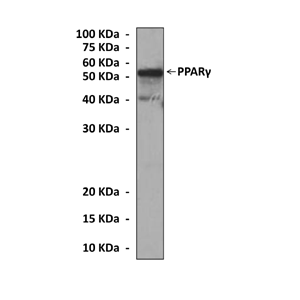Anti-PPARγ: Mouse Peroxisome Proliferator-Activated Receptor gamma Antibody |
 |
BACKGROUND The Peroxisome Proliferator-Activated Receptors (PPARs; NR1C) belong to the steroid/thyroid/retinoid receptor superfamily and are nuclear lipid-activable receptors that control a variety of genes in several pathways of lipid metabolism, including fatty acid transport, uptake by the cells, intracellular binding and activation, as well as catabolism (beta-oxidation and omega-oxidation) or storage. In addition to being indeed activated by fatty acids, they respond to fibrate hypolipidemic drugs and to insulin sensitizers. Three related PPAR isotypes have been identified in vertebrates. They were named PPARalpha (NR1C1), PPARbeta (NR1C2), and PPARgamma (NR1C3).1
A variety of substances have been suggested to be natural ligands for PPARgamma, including fatty acids and eicosanoids, components of oxidized low-density lipoproteins, and oxidized alkyl phospholipids including lysophosphatidic acid and nitrolinoleic acid. PPARgamma ligands exert their effect through PPARgamma-dependent (genomic) and PPARgamma-independent (non-genomic) mechanisms. Binding of PPARgamma to specific DNA sequences requires heterodimerization with a second member of the nuclear receptor family, retinoic X receptor (RXR). Binding of agonist ligands to PPARgamma triggers a conformation change that attracts transcriptional coactivators, including members of the steroid receptor coactivator (SRC) family. In the absence of ligand, PPARgamma has the potential to actively silence genes to which it is bound by recruiting transcriptional corepressor complexes containing nuclear receptor corepressor (N-CoR) or SMRT (silencing mediator of retinoid and thyroid receptors). The transcriptional coactivators and corepressors exist in multiprotein complexes including histone-modifying enzymes, such as histone acetyltransferases (notably p300/CBP) and histone deacetylases (notably HDAC 3), respectively. The activity of these histone-modifying enzymes affects gene transcription by altering chromatin structure.2
A variety of substances have been suggested to be natural ligands for PPARgamma, including fatty acids and eicosanoids, components of oxidized low-density lipoproteins, and oxidized alkyl phospholipids including lysophosphatidic acid and nitrolinoleic acid. PPARgamma ligands exert their effect through PPARgamma-dependent (genomic) and PPARgamma-independent (non-genomic) mechanisms. Binding of PPARgamma to specific DNA sequences requires heterodimerization with a second member of the nuclear receptor family, retinoic X receptor (RXR). Binding of agonist ligands to PPARgamma triggers a conformation change that attracts transcriptional coactivators, including members of the steroid receptor coactivator (SRC) family. In the absence of ligand, PPARgamma has the potential to actively silence genes to which it is bound by recruiting transcriptional corepressor complexes containing nuclear receptor corepressor (N-CoR) or SMRT (silencing mediator of retinoid and thyroid receptors). The transcriptional coactivators and corepressors exist in multiprotein complexes including histone-modifying enzymes, such as histone acetyltransferases (notably p300/CBP) and histone deacetylases (notably HDAC 3), respectively. The activity of these histone-modifying enzymes affects gene transcription by altering chromatin structure.2
The PPARgamma activity can be regulated by phosphorylation. It was shown that PPARgamma was phosphorylated by ciglitazone-induced activation of Erk1/2. PPARgamma phosphorylation affected the genomic pathway by being inhibitory to PPAR -DNA binding and PPRE transcriptional activity, as well as the non-genomic pathway by increasing the physical interaction of PPARgamma with p65, leading to the inhibition of NF-kappabeta.3 In addition, CK-II-dependent PPARgamma phosphorylation at Ser16 and Ser21 is necessary for CRM1/Ran/RanBP3-mediated nucleocytoplasmic translocation of PPARgamma.4
PPARgamma indeed has many faces. It is the master regulator of adipocyte differentiation yet promotes insulin sensitivity. It enhances macrophage lipid uptake as well as lipid export and has anti-inflammatory effects. It is generally antiproliferative yet has been suggested to exacerbate the growth of certain tumors. Hence, targeting this receptor for therapeutic purposes while minimizing side effects represents a great challenge. Nevertheless, it is clear that selective PPARgamma modulation of desired gene sets can be achieved by targeting corepressor interactions, separating transactivation from transrepression, and favoring specific subsets of coactivators. The specific modulation of these properties of PPARgamma should allow optimization of tissue and target gene specificity, thereby enhancing therapeutic efficacy, particularly for metabolic diseases, while reducing undesired side effects that are limitations for the PPARgamma compounds currently in the clinic.5
Recent Publication
Kim, K.S., H.M. Choi, H.I. Ji, C. Kim, J.Y. Kim, R. Song, S.M. Kim, Y.A. Lee, S.H. Lee, H.I. Yang, M.C. Yoo, and S.J. Hong. 2013b. Effect of taurine chloramine on differentiation of human preadipocytes into adipocytes. In Advances in experimental medicine and biology. Vol. 775. 247-257.
REFERENCES
1. Savage, D.B.: Expert Rev Mol Med. 7:1-16, 2005
2. Duan, S.Z. et al: Circ Res. 102:283-94, 2008
3. Chen, F. et al: J. Cell. Biochem. 90:732-44, 2003
4. von Knethen, A. et al: J. Cell Sci. 123:192-201, 2010
5. Desvergne, B. & Wahli, W.: Endocrinol. Rev. 20:649-88, 1999
2. Duan, S.Z. et al: Circ Res. 102:283-94, 2008
3. Chen, F. et al: J. Cell. Biochem. 90:732-44, 2003
4. von Knethen, A. et al: J. Cell Sci. 123:192-201, 2010
5. Desvergne, B. & Wahli, W.: Endocrinol. Rev. 20:649-88, 1999
Products are for research use only. They are not intended for human, animal, or diagnostic applications.
Параметры
Cat.No.: | CP10202 |
Antigen: | Purified recombinant human PPAR gamma fragments expressed in E. coli. |
Isotype: | Mouse IgG1 |
Species & predicted species cross- reactivity ( ): | Human |
Applications & Suggested starting dilutions:* | WB 1:1000 IP n/d IHC n/d ICC 1:100 FACS n/d |
Predicted Molecular Weight of protein: | 53/57 kDa |
Specificity/Sensitivity: | Detects PPAR gamma proteins without cross-reactivity with other family members. |
Storage: | Store at -20°C, 4°C for frequent use. Avoid repeated freeze-thaw cycles. |
*Optimal working dilutions must be determined by end user.
Документы
Информация представлена исключительно в ознакомительных целях и ни при каких условиях не является публичной офертой








